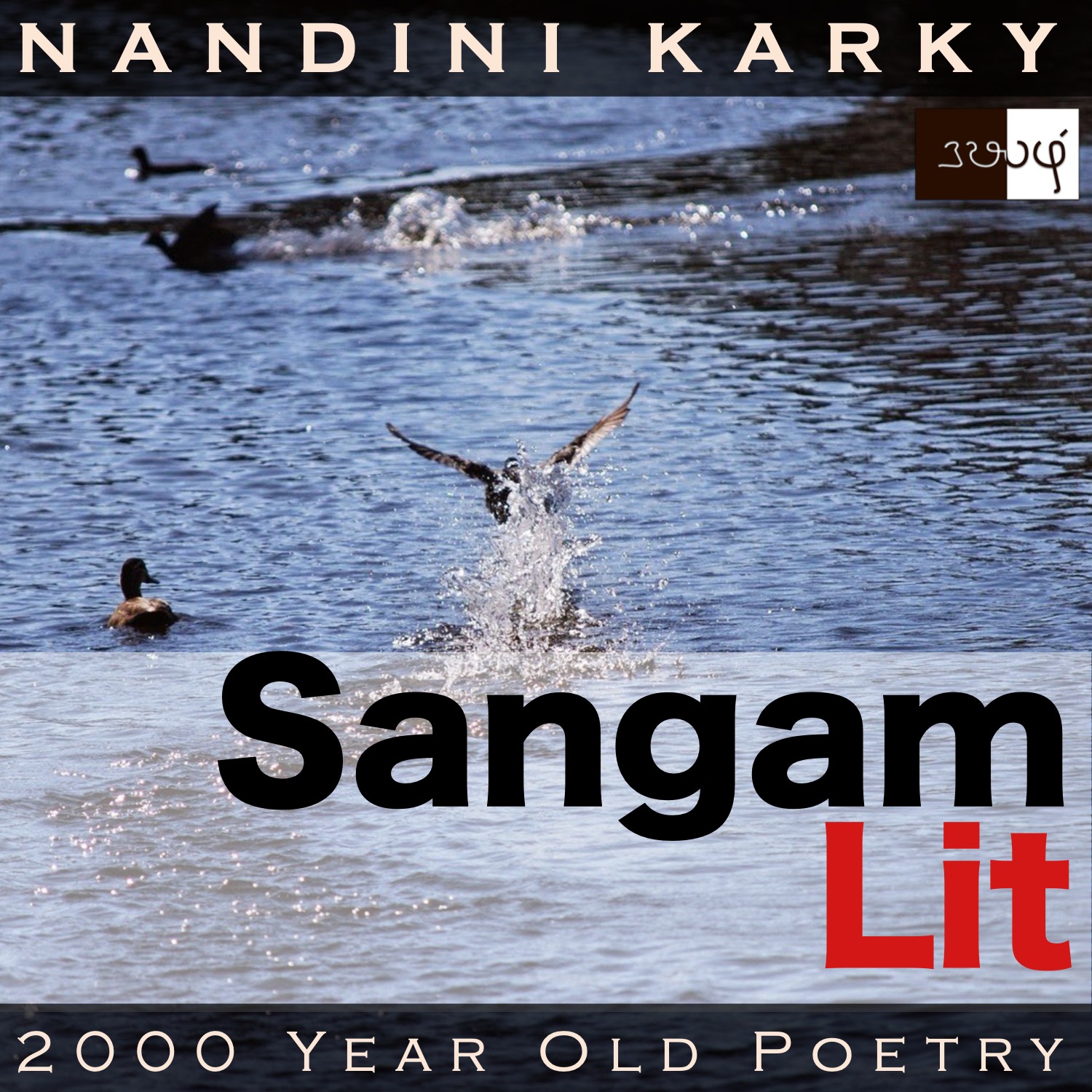Podcast: Play in new window | Download
Subscribe: Apple Podcasts | Spotify | Amazon Music | Android | iHeartRadio | TuneIn | RSS | More

In this episode, we marvel at the rich imagery that brings out life in ancient times, as depicted in Sangam Literary work, Natrinai 231, penned by Ilanaakanaar. The verse is set in the coastal regions of ‘Neythal’ and speaks in the voice of the confidante to the lady, passing on a hidden message to the man, listening nearby.
மை அற விளங்கிய மணி நிற விசும்பில்
கைதொழும் மரபின் எழு மீன் போல,
பெருங் கடற் பரப்பின் இரும் புறம் தோய,
சிறு வெண் காக்கை பலவுடன் ஆடும்
துறை புலம்பு உடைத்தே-தோழி!-பண்டும்,
உள் ஊர்க் குரீஇக் கரு உடைத்தன்ன,
பெரும் போது அவிழ்ந்த கருந் தாட் புன்னைக்
கானல்அம் கொண்கன் தந்த
காதல் நம்மொடு நீங்காமாறே.
Opening with ‘மை அற’ meaning ‘impeccable’, the poem evokes a quality of pristine beauty. We learn that this adjective has been applied to the ‘blue skies’ as seen in ‘மணி நிற விசும்பில்’. Thereafter, we encounter a significant phrase ‘கைதொழும் மரபின் எழு மீன் போல’ meaning ‘like the seven stars that have been worshipped traditionally’. So much lies within this expression, which we will explore in a moment. ‘சிறு வெண் காக்கை’ or the ‘little seagulls’ delight us by playing about in the sea. When we see ‘துறை புலம்பு உடைத்தே’, we understand that personification of an inanimate object is at play, for it means ‘the shore is brimming with loneliness’. Other life forms such as ‘உள் ஊர்க் குரீஇ’ ‘house sparrow’ and ‘கருந் தாட் புன்னை’ ‘black-stemmed laurel tree’ greet us in this verse. Let’s walk along this shore and explore more!
The man and lady had been leading a love relationship and the man trysts with the lady by the shore. The confidante decides it’s time to urge him to formalise his union with the lady. So, one day, when he arrives by the trysting spot, pretending not to see him, the confidante says to the lady, “Like the seven stars worshipped as part of tradition, up in the flawless-looking, sapphire-hued sky, many small white gulls play together, drenching their dark backs, in the vast spread of the ocean. This joyful shore is filled with loneliness today! Akin to the broken shell of a house sparrow’s egg, the flowers of the black-trunked ‘punnai’ blooms in the sands of the lord’s domain. The lord, whose love for you, fades not from your heart!” With these words, the confidante expresses that the lady pines for the man in his absence and that the man must strive to alleviate this suffering by seeking the lady’s hand in marriage.
Now, for the delightful nuances that fill this verse! The confidante opens this verse by bringing to our attention the faultless, azure skies above and in this expanse, she points to the seven stars, which she refers to, as objects worshipped in their tradition. Let’s step aside from the poem and take this in fully. The seven stars referred here point to the Ursa Major or the ‘Great Bear’ Constellation, seen in the northern sky and which finds a resonance in many ancient cultures. On researching more about this, learnt that there is an Indus sign, related to astronomy, represented by a fish symbol and seven lines. This symbol is the direct translation of the word ‘எழு மீன்’ or ‘seven stars’. Thus, in both cultures, the ‘star’ has been visualised as a ‘fish’ that swims in the sea-like sky. This offers a tiny glimpse of what could be a possibly deep connection between the Indus Valley and Sangam civilisations. Stepping back into the verse, we hear the confidante mention the seven stars in the sky as a simile for the many seagulls playing together in the vast ocean before them. From this joyous description, the confidante changes the mood by saying that such a happy shore is now filled with the pain of loneliness.
The confidante describes the man’s shore as one filled with ‘punnai’ trees, whose full-bloomed flowers look as if a sparrow’s egg has been split open. To fully admire the aptness of this comparison, place the images of a laurel tree flower and a broken sparrow’s egg side by side. You will come away impressed by this skill of connecting disparate things – the true mark of creativity! After describing the man’s land so, the confidante says that the shore seems lonely because the lady’s heart is filled with thoughts of the man’s love, who does not grace her with his company at the moment. When she mentions the joyous play of seagulls with their mates, the confidante points out the pining in the lady’s heart as she does not get to be with the man like those birds and their mates. Through these stunning images, the confidante urges the man to let go of his temporary trysting and bring lasting relief to the lady by seeking her hand in marriage. Delving into a few lines of verse, we have expanded our understanding of history, astronomy, biology and psychology. This vividly illustrates that true learning can only be obtained from such a holistic perspective!




Share your thoughts...